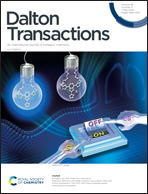Selective detection of sulfide in human lung cancer cells with a blue-fluorescent “ON–OFF–ON” benzimidazole-based chemosensor ensemble†
Abstract
A completely water-soluble, high quantum yield blue-fluorescent benzimidazole derivative (AQ), containing a rigid benzimidazole-thiophene structure, was synthesized. Among 21 metal ions, the fluorescence of AQ was selectively turned off by Cu2+ to form an AQ-Cu2+ ensemble. Thereafter, the fluorescence of the AQ-Cu2+ ensemble was turned on by sulfide (S2−) with high selectivity and sensitivity in pure water solution. In comparison with AQ-Ag+ and AQ-Hg2+ ensembles, AQ-Cu2+ was the only ensemble that was capable of detecting a sulfide anion. Also, the fluorescence intensity of AQ was linearly proportional to the concentration of Cu2+ and S2−. Both Cu2+ and S2− were detected within a minute in vitro. Moreover, AQ worked best in the pH range of 5–10 and had a limit of detection of 50 nM and 354 nM for Cu2+ and S2− respectively. It was employed for the detection of sulfide in human lung cancer A549 cells with low cytotoxicity.



 Please wait while we load your content...
Please wait while we load your content...